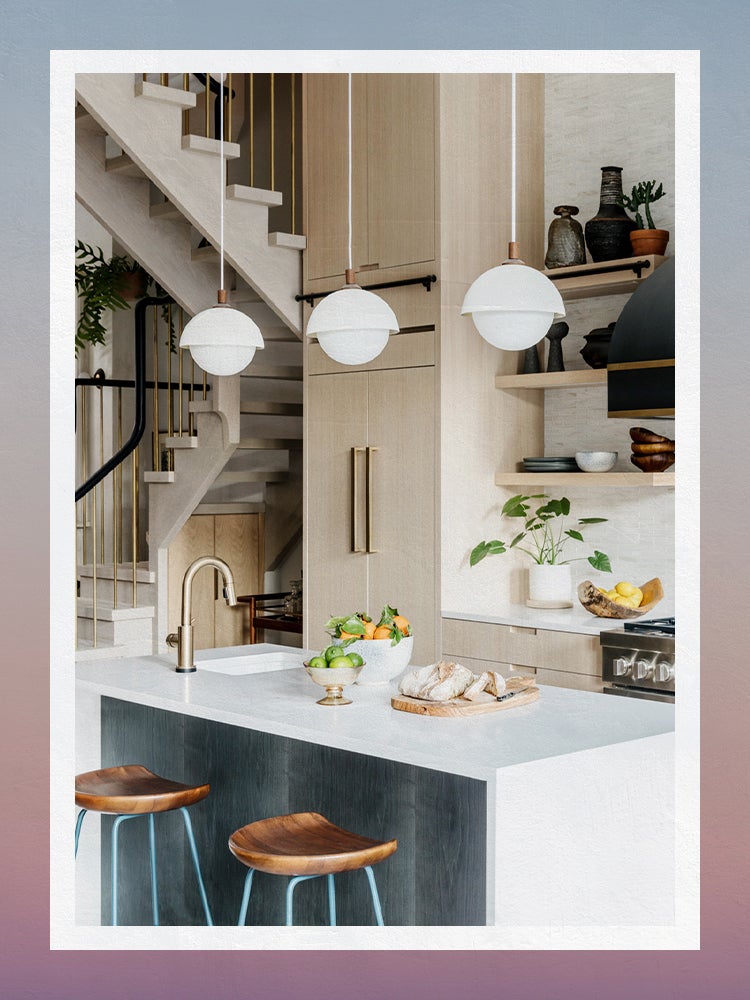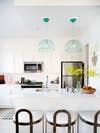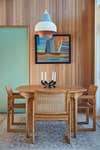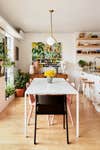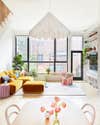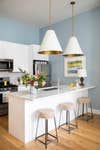The 7 Best Pendant Lights, as Seen in Domino’s Favorite Homes
There’s even a rental-friendly option.
Published Dec 21, 2021 1:00 AM
We may earn revenue from the products available on this page and participate in affiliate programs.
“Designers either pick lighting first or last,” says Brigette Romanek, the founder of Romanek Design Studio. “I think of it as putting on jewelry, so it’s the last thing I choose for a space. The right pendant really helps define and enhance the look you’re going for.” But given that the fixtures can get expensive, usually require professional installation, and must meet both aesthetic and functional needs, it’s no wonder shoppers feel intimidated. Many wait until the very last minute because they’re overwhelmed by options and afraid to get the wrong one. It can be hard to envision how one will fit into a space or whether it will look right over the dining room table.
A pendant (or two or three) can transform a kitchen, pull together a living room, or add that necessary touch of glamour to a bathroom. If you’re refreshing a space, try to budget for lighting, as dated fixtures can really hold a room back. To help you find the best pendant light for your space, we turned to some of our favorite home tours for inspiration and also tapped experts, including Romanek, to break down everything you need to know. Our curated selection of pendants features unique shapes and materials, classic designs that will never go out of style, and a compelling case for adding some color overhead.
Our Favorites
- The rental-friendly one: Pearl River Mart Paper Lantern
- The playful plastic one: Kartell FL/Y Pendant
- The color-blocked one: Louis Poulsen Cirque Pendant
- The sleek one: Flos IC Pendant
- The felt one: Menu Dancing Pendant
- The oversize one: Visual Comfort Goodman Large Hanging Lamp
- The minimalist one: Allied Maker Dome Pendant
The Rental-Friendly One: Pearl River Mart Paper Lantern
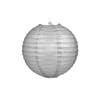
Room type: Living room, bedroom | Material: Paper, wire | Power source: Doesn’t come with one, so buy a cord set to plug in
What we like:
- Understated elegance
- Extremely lightweight, so it doesn’t require extensive work to hang
Worth noting:
- Doesn’t come with a plug
- Supply-chain disruption means some sizes are currently out of stock
Why we chose it: A simple, airy fixture that offers a big impact at a great price point.
“Everyone is afraid to change the light fixtures in a rental, but honestly it’s wildly worth it,” says Lily Sullivan, a former Domino staffer who shared her rental apartment with us earlier this year. “I wanted something with a bit of drama that also would be light in the space. I had a few heavy moments and thought that the weightlessness of a lantern would pair well.” She turned to Pearl River Mart, a New York institution, for a low-budget, high-impact light. The pendant is available in 17 sizes, from the tiny 4-inch version (which wouldn’t fit a lightbulb) to a massive 48-inch shade.
“My furniture is fairly low, so an oversize pendant worked superwell,” explains Sullivan. She used a cord set from IKEA, since the pendant doesn’t come with one. It was easy to install and—key for a rental—easy to remove without repairs. Also, if you want to add a pendant where there is no existing junction box, this plug-in option is ideal.
The Playful Plastic One: Kartell FL/Y Pendant
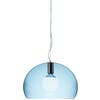
Room type: Kitchen, dining room, kids’ room | Material: Plastic or metal | Power source: Hardwired
What we like:
- Multiple color and finish options
- A great shape
Worth noting:
- The bulb is exposed
Why we chose it: A shot of color and a pleasing rounded shape would be a welcome addition to an otherwise functional space.
After moving into the Manhattan rental apartment she shares with her husband and young son, Cyndi Ramirez-Fulton made a few changes, including adding some new lighting. Over the kitchen island, she replaced can lights with Kartell’s FL/Y pendant. “It’s such a game changer,” she said of the switch during a tour of her home.
In a utilitarian space like a kitchen, layering in a playful shape or bit of color is a great way to add some lived-in warmth. For a remodel, if you’re drawn to color but don’t want to go bold with kitchen cabinets or tiling because it’s expensive to replace, lighting is a great place to take that risk (and since you’re adding color, not metal, you don’t have to worry about elements clashing or looking too matchy-matchy either).
Designed by Ferruccio Laviani in 2002, this pedant calls to mind a soap bubble, but since it’s rendered in durable plastic, breakage isn’t a concern. It’s also available in two larger sizes, a number of vibrant colors, and a few metal finishes.
The Color-Blocked One: Louis Poulsen Cirque Pendant
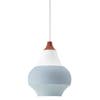
Room type: Living room, dining room, kitchen, kids’ room | Material: Aluminum | Power source: Hardwired
What we like:
- Available in three sizes
- Four color schemes could be mixed for a multi-pendant display
- Gives off glare-free, soft light due to the white lacquered interior
Worth noting:
- The largest size is only 15 inches in diameter
Why we chose it: Color isn’t just for walls—it can also hang from the ceiling, as in this sculptural creation from Denmark.
This pendant, which comes in four variations and three sizes, was inspired by the colors and shapes at the Tivoli Gardens, an amusement park in Copenhagen that dates back to 1843. Jennifer Mankins added one above the dining table in her colorful second home on Shelter Island, New York, pictured above.
“In the past few years, so many areas of design that have been considered strictly functional, like lighting, have also become fun,” says Romanek. A pendant like this is a great way to add color in an otherwise neutral space—or to build cohesion in a more colorful space by pulling together a shade or two from textiles or tiles. It would be great in a children’s room but, as shown above, doesn’t look out of place in an adult space either.
“These pendants are great for clustering and staggering, so you get dimension and visual interest with the ability to mix up the different sizes and colors,” says Ashley Rutter, an American Lighting Association certified consultant at Lightology. “Plus they look just as great off as they do on!”
The Sleek One: Flos IC Pendant
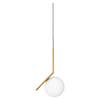
Room type: Kitchen, living room, dining room, hall | Material: Glass with brass, chromed steel, or powder-coated steel frame | Power source: Hardwired
What we like:
- The globe casts even light around the room
- Available in two sizes
Worth noting:
- Even the larger size is under a foot wide, so it may be dwarfed by tall ceilings or an especially large room
Why we chose it: This is an exquisitely rendered exercise in simplicity from an industry stalwart.
As Romanek points out, lighting is often considered jewelry for the home, so it’s cool to see what an actual jewelry designer chose to light up her space. In the case of Caitlin Mociun’s Brooklyn apartment, it was a delicate brass frame holding a glass globe. “What makes IC pendants special is the purity of form, the build quality, the light quality, and the gentleman who designed it,” says Noah Schwarz, creative director at Design Within Reach. “There’s certainly a reason it’s been knocked off by so many—it’s really good.”
The pendant was designed by Michael Anastassiades, whose work resides in the permanent collection of the Museum of Modern Art in New York and the Victoria and Albert Museum in London. The IC is a relatively affordable way to bring a piece of his work into your private collection…whether that’s a tiny apartment or a sprawling house.
The Felt One: Menu Dancing Pendant
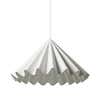
Room type: Living room, dining room, kitchen, bedroom | Material: Polyester felt | Power source: Hardwired
What we like:
- Felt makes the pendant more opaque, concentrating the light in a downward direction
- It’s great to balance traditional metal lighting options with a textured textile
Worth noting:
- By the same token, the felt prevents the light from spreading upward and around the room evenly
Why we chose it: A movement-inspired piece in an unexpected material makes for a unique pendant.
“Picking out lighting during a renovation is definitely overwhelming, especially when you have to choose lighting for every part of the home,” says Linda Bui, whose Brooklyn row house renovation is pictured above. She shares the space with her husband and young daughter. “We knew we wanted some more ‘special’ pieces on the first floor, which has an open layout that includes the kitchen, dining, and living area,” adds Bui. Since the dining area is the center of the space, they wanted the pendant there to have the most impact. Menu’s oversize felt pendant “looks like a sculpture with all the curves,” she says. The light is the work of Iskos-Berlin, a design duo inspired by “clear yet surprising” storytelling, according to the Danish Design Store; the instantly recognizable image of a swirling skirt that’s conjured by this pendant is a great example.
Adding an unexpected texture to lighting can be a great way to mix things up. “I’m beginning to see a shift toward natural materials and a recognition that lighting can be something other than the seemingly ubiquitous steel and glass fabrications that dominate the industry today,” says Schwarz.
The Oversize One: Visual Comfort Goodman Large Hanging Lamp
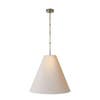
Room type: Kitchen, dining room | Material: Metal with multiple shade options | Power source: Hardwired
What we like:
- The brass interior gives off a glowy warmth
- It’s designed by Thomas O’Brien, who is known for his sophisticated lighting
Worth noting:
- It works best with a tall ceiling
Why we chose it: With a classic shape, delicately linked chain, and brass shade interior, this traditional pendant will draw eyes…and compliments.
“I love the classic, refined silhouette of the Goodman,” says Alexandra Morris, a stylist who installed the pendant (times two) in her Philadelphia rental. “I wanted a fixture that complemented my collected vintage and antique furnishings, as well as the modern-style cabinets in my kitchen. It’s so versatile, and the fixture emits a substantial amount of light, which was a priority as well.” It’s no surprise the Goodman is one of Circa Lighting’s best-sellers. While the dramatic shade is available in multiple sizes, Morris recommends going as big as you can. “People think fixtures need to be on the smaller side, but I suggest measuring the height above and trying to get a sense of just how big you can go,” she says. “I am a strong proponent of overscale hanging fixtures. It often makes a space feel bigger and taller.”
The Minimalist One: Allied Maker Dome Pendant
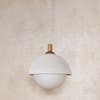
Room type: Kitchen, dining room, laundry room, bathroom, basement, covered porch | Material: Brass, glass, and wood, available in a variety of finishes | Power source: Hardwired
What we like:
- Five glass finish options, from clear to frosted
- Handmade in the U.S.
- Can be used in a damp location
Worth noting:
- The high price tag makes it harder to use in multiples
Why we chose it: It’s a well-crafted pendant with beautiful details and textural dimension.
“I really love the mixing,” Estelle Bailey-Babenzien said of the space she designed for actor Adrian Grenier’s mother. “Finding parts that balance each other out as complements is so important. You can have an IKEA kitchen, but with beautiful tiles. Swapping out some hardware and adding a special pendant light changes everything.” The appealing curve of this pendant, paired with its thin, perforated shell, make for a stunning design. It’s highly customizable, with a variety of wood finishes (including American ash and black walnut), a number of dome and globe options, and four different sizes.
This pendant is also UL and damp certified. Underwriters Laboratories (UL) is a nonprofit, independent organization focused on consumer safety, and the UL certification signifies a high-quality, safe product. The damp certification means it can go in spaces with moisture or condensation, like a bathroom, drafty basement, or covered patio. (Wet-certified pendants, on the other hand, can be exposed to direct rain or snow.) This does mean a slightly higher price tag, because the safety standards for damp and wet spaces are more expensive to meet.
How We Chose These Products
First, we turned to some of our favorite home tours, picking out pendants we love and have seen used to great effect again and again. Next, we asked professionals, homeowners, and renters with a great eye for design why they chose the pendants and why it works well in their space. We included lights from brands that sell durable, high-quality pieces (because the last thing you want after installing a pendant is to hear it come crashing down). Finally, we talked to experts in the field to learn more about how to get pendant lighting right.
Pros on the Power of the Pendant
- “When arranging a row of lights (along a kitchen island, etc.), I find that simple geometric forms are often best. And stick to just one color to unify the group,” says Design Within Reach’s Schwarz.
- “If you are hanging your pendant in a space where people will walk under the light, you don’t ever want to hang it lower than 7 feet,” says Rutter of Lightology.
- “Having a simple pendant done beautifully is just as engaging as a really grand pendant,” says Romanek.
- Don’t forget the shadows. “I have had clients buy pendants that have cutouts and pierced patterns in the shade that typically throw creative shadows on the walls and ceiling,” notes Rutter. “A patterned shadow can look great in a kids’ room or above a wet bar, but it’s not so great next to your makeup mirror.”
Our Shopping Checklist
Function
“I know it sounds obvious, but when choosing a fixture, you need to make sure it will give off enough light,” says Rutter. Material is a big part of that, as is the shape of the fixture or shade. When thinking about function, it’s also key to consider the room’s other sources of light. Will you have table lamps? Recessed lighting? A floor lamp in a corner? Unless it’s a hallway, a room should have multiple sources of lighting. “If you have layers of lighting, like recessed cans and floor and table lamps, you can get away with a stylish pendant that doesn’t necessarily put out as many lumens,” adds Rutter. If not, you might need a globe pendant that casts light all over the room. Lighting sources will sometimes label the type of light the pendant casts: Look for “up light,” “down light,” or “up-and-down light.”
Shade
The material of the shade impacts the kind of light it gives off. “If a pendant shade is an opaque material—like metal or concrete—you only get light coming down rather than out,” says Rutter. “If the shade is transparent or semitransparent—like glass or fabric—typically you will get light coming out in all directions, illuminating more of your space. A pendant with a domed metal shade will give you light in one direction, but a glass globe will throw light in all directions.” Think about what you need from your pendant, figure out the material or shape that will work best, and then find options that fit those needs.
Size
“We were definitely those people who ordered it online before we were able to see it in person,” says Bui of selecting the Menu Dancing pendant. “The biggest thing we didn’t notice in photos that was very apparent in person was the size. It’s a lot larger than it seemed. The dimensions were listed, but it was hard to imagine what that size would look like in the dining area until it was already up.” Thankfully the sizing worked out spectacularly for Bui, but generally speaking, it’s a good idea to measure out the size in the room or mock up the pendant using a piece of scrap cardboard to really get a sense of how it will fit in your space or in relation to a table. And if you can view the pendant in person, do so. “I typically find that spaces suffer from undersize lighting,” says Schwarz. “Especially when you have the luxury of high ceilings and a large volume of space, go big!” Of course, for hallways or anywhere headspace is an issue, you’ll want something smaller.
Plug-in vs. Hardwired
“A plug-in is a great solution when your vision for lighting a space differs from that of the contractor who originally built it,” says Schwarz. You may not have a junction box in the ceiling or want to pay to update the electric wiring in a room, but that doesn’t mean you can’t have an overhead light. You can try to disguise the plug by using one that is the same color as the ceiling or tucking it behind art or a tall piece of furniture as it moves down the wall. But these days, emphasizing the cord by using a colorful option is a fun way to deal with the issue.
Indoor vs. Outdoor
Your average pendant is rated to hang in a dry indoor space. But areas that get damp, like bathrooms and basements, will need a damp-rated fixture, and an outdoor placement, like above a front door or flanking the garage door, will need a wet-rated pendant. Often a pendant’s damp or wet certification will be listed, but always ask if you are looking for something to hang outside or in a space with condensation.
Ask Domino
Q: How many pendant lights should I hang over a kitchen island? How big should they be?
“While we tend to crave symmetry in design, when hanging multiple pendants, odd numbers work better,” says Romanek. “It’s a bit more interesting.” Exactly how far apart they should be depends on the shade or the globe of the pendant and also on the size of the island. For Romanek, a minimum of 14 inches should be left between pendants, though she often puts 18 inches between pendants and sometimes goes up to 24 inches if the fixtures are large. Rutter offers some of her tried-and-true numbers for how low to hang a pendant over the kitchen island: “When hanging a pendant over a dining table or kitchen island, you typically want to leave 30 to 36 inches from the top of the table to the bottom of the pendant,” she says.
Q: What’s the deal with LED lights, and how do I avoid ending up with a superstark space that feels like a dentist’s office?
We turned to Rutter to break this down. She explains: “If it’s an LED pendant, lumens and color temperature are a huge factor. Lumens tell you how much light you are going to get: The higher the lumens, the brighter the light. Color temperature (listed in Kelvins) is important as well. You can think of color temp as the ‘mood’ your light will set.”
When it comes to color temperature, Rutter says that “low color temperatures (1,800K to 2,700K) create a warmer atmosphere, similar to an incandescent bulb. Higher color temperatures (3,500K to 4,000K) create a cooler atmosphere, with the light being whiter. There are different reasons to use a variety of color temperatures. You might use a lower color temp in a bedroom to create a cozy atmosphere, and you might use a higher color temp in an office or a gym, where you want to stay alert and focused. Most people prefer the 2,700K to 3,000K range.”
The Last Word
While choosing the right lighting can feel intimidating, it’s a great opportunity to bring that final layer of style to your space and add a touch of whatever the room is missing (like color, glamour, or texture) in addition to necessary light. “The impact that good lighting can have on your mood—and your ability to appreciate your space—can’t be overemphasized,” says Schwarz. It’s such a joy to walk into a room, turn on the light, and like what you see. And it’s all the more satisfying when you’ve had a hand in picking it out.
